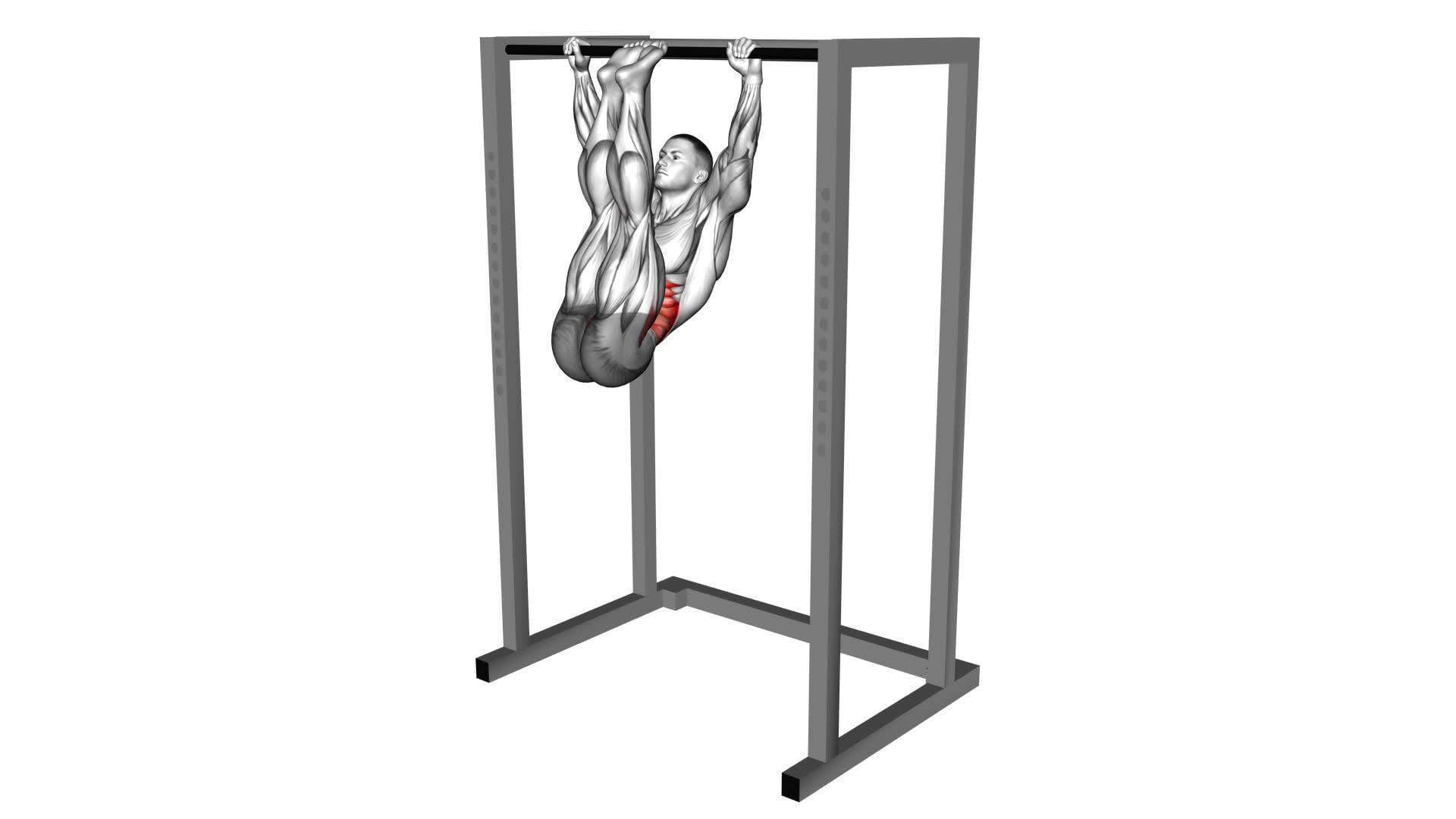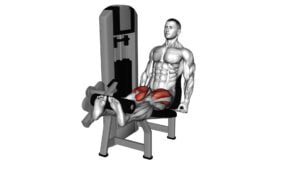Hanging Toes to Bar – Video Exercise Guide & Tips

Are you looking to challenge your core and build upper body strength? Look no further than hanging toes to bar!
Watch This Exercise Video
This exercise targets your abs, obliques, and upper body, all while improving your grip strength.
In this video exercise guide, you'll learn the proper form and technique, common mistakes to avoid, and tips for progressing and increasing difficulty.
Get ready to elevate your fitness game with hanging toes to bar!
Key Takeaways
- Hanging toes to bar targets the abs, obliques, and upper body.
- It improves grip strength and engages multiple muscle groups simultaneously.
- Proper form and technique, such as engaging the core and avoiding swinging, are essential for effective execution.
- Progression and increasing difficulty can be achieved through variations, tempo changes, and incorporating other exercises.
Benefits of Hanging Toes to Bar
The hanging toes to bar exercise offers several benefits that can improve your core strength and flexibility. This exercise primarily targets your abdominal muscles, including the rectus abdominis, transverse abdominis, and obliques. By engaging these muscles, you can develop a stronger core, which is essential for stability and balance in various movements and activities.
Incorporating hanging toes to bar into a full-body workout can be highly effective. It not only targets your core but also engages your upper body, particularly your shoulders, arms, and back muscles. The movement requires you to hang from a pull-up bar and raise your legs until your toes touch the bar. This action activates your lats, deltoids, biceps, and forearms, helping to improve overall upper body strength and muscular endurance.
To include hanging toes to bar in your workout routine, you can perform it as part of a circuit, alternating with other exercises such as push-ups, squats, or lunges. This way, you can work different muscle groups while keeping your heart rate elevated for cardiovascular benefits.
Now that you understand the benefits of hanging toes to bar, let's dive into the next section: proper form and technique. Mastering the correct form is crucial to maximize the effectiveness of this exercise and prevent injuries.
Proper Form and Technique
To perform the hanging toes to bar exercise with proper form and technique, follow these steps:
- Start by hanging from a pull-up bar with your arms fully extended and your shoulders relaxed.
- Engage your core muscles by pulling your belly button towards your spine.
- Bend your knees and lift your legs up towards the bar, aiming to touch your toes to the bar.
- As you lift your legs, use your core strength to control the movement and avoid swinging.
- Slowly lower your legs back down to the starting position, maintaining control throughout the entire movement.
Improving flexibility is crucial for this exercise as it allows you to achieve a greater range of motion and reach the bar with your toes. Stretching exercises such as leg raises and hamstring stretches can help increase flexibility in the lower body.
Building core strength is also essential for performing hanging toes to bar effectively. Strengthening exercises like planks, Russian twists, and bicycle crunches can help develop the necessary core muscles to lift your legs and control the movement.
Common Mistakes to Avoid
To avoid common mistakes and ensure proper execution of the hanging toes to bar exercise, it's important to maintain control and avoid swinging your legs. One of the most common mistakes people make is using momentum to swing their legs up, rather than relying on their core strength. This not only reduces the effectiveness of the exercise but also increases the risk of injuries. Instead, focus on engaging your core muscles and using controlled movements to lift your legs towards the bar.
Another mistake to avoid is neglecting modifications for beginners. If you're new to the exercise or lack the necessary upper body strength, it's important to start with easier variations. For example, you can begin by performing knee raises instead of full toes to bar. This modification allows you to build strength and gradually progress towards the full exercise.
Tips for Progression and Increasing Difficulty
To progress and increase the difficulty of the hanging toes to bar exercise, you can incorporate various techniques and modifications over time. Here are some progression strategies and strengthening exercises to help you take your hanging toes to bar to the next level:
- Start with knee raises: If you're new to the exercise, begin by focusing on knee raises. This will help you build the necessary core strength and control before attempting full toes to bar.
- Increase range of motion: Gradually work on increasing the height at which you bring your toes to the bar. This will challenge your core and hip flexor muscles even more.
- Add weight: Once you can perform toes to bar with ease, you can make it more challenging by adding ankle weights or holding a dumbbell between your feet.
- Incorporate tempo variations: Try slowing down the movement, emphasizing the eccentric (lowering) phase, or pausing at the top of the movement to increase time under tension and build strength.
- Explore different grips: Experiment with different grip variations, such as a pronated (overhand) or supinated (underhand) grip, to target different muscle groups and add variety to your workout.
By implementing these progression strategies and incorporating strengthening exercises, you can continue to challenge yourself and improve your hanging toes to bar technique.
Now, let's move on to a sample hanging toes to bar workout.
Sample Hanging Toes to Bar Workout
For a sample hanging toes to bar workout, try incorporating the following exercises into your routine. These exercises will help you build strength and improve your technique in hanging toes to bar variations.
Start with a warm-up consisting of dynamic stretches and mobility exercises for your shoulders, core, and hips. This will prepare your body for the workout ahead and reduce the risk of injury.
Begin with the basic hanging knee raise. Hang from a bar with your arms fully extended, then engage your core and lift your knees towards your chest. Focus on maintaining control and a slow and controlled descent.
Once you feel comfortable with the knee raise, progress to the hanging leg raise. Keep your legs straight as you lift them towards the bar, aiming to touch your toes to the bar if possible. Again, focus on control throughout the movement.
To further challenge yourself, incorporate variations such as the toes to bar. This involves lifting your legs up while keeping them straight until your toes touch the bar.
To incorporate hanging toes to bar into a full body workout routine, consider pairing it with exercises like pull-ups, push-ups, squats, and planks. This will ensure that you're targeting multiple muscle groups and getting a well-rounded workout. Remember to rest between sets and listen to your body to prevent overexertion.
Frequently Asked Questions
What Are the Different Variations of the Hanging Toes to Bar Exercise?
There are several variations of the hanging toes to bar exercise that you can try. These include bent knee toes to bar, knees to chest, and windshield wipers.
Each variation provides a different level of difficulty and targets different muscles in your core.
It's important to progress gradually and focus on proper form to avoid common mistakes such as swinging or using momentum.
Demonstrations of these variations can be found in the Hanging Toes to Bar – Video Exercise Guide & Tips {389112}.
Incorporating these variations into your workouts can help improve your core strength and overall fitness.
How Many Reps and Sets Should I Aim for When Performing Hanging Toes to Bar?
When performing hanging toes to bar, it's important to focus on proper technique and form.
Start by determining the optimal training frequency for yourself, keeping in mind that everyone's body is different.
Gradually increase the number of reps and sets as you progress to challenge yourself.
Remember to engage your core and use controlled movements throughout the exercise.
This will help you build strength and stability in your upper body and core muscles.
Can I Perform Hanging Toes to Bar if I Have a Shoulder Injury?
If you have a shoulder injury, you may want to avoid performing hanging toes to bar. It puts a lot of strain on your shoulders, which could worsen your injury.
However, there are modifications you can make to avoid shoulder strain. You can try performing knee raises instead of fully extending your legs. This will still engage your core muscles without putting as much stress on your shoulders.
Always listen to your body and consult with a healthcare professional before attempting any exercise with an injury.
What Muscles Are Targeted When Performing Hanging Toes to Bar?
When you perform hanging toes to bar, several muscles in your upper body and core are targeted. The primary muscles worked are your abdominals, including the rectus abdominis and obliques. Additionally, your hip flexors, lats, and forearms are engaged.
This exercise not only strengthens these muscles but also improves your grip strength and overall body control. The benefits of hanging toes to bar include developing core stability, enhancing upper body strength, and improving your ability to perform other gymnastic movements.
How Can I Modify the Hanging Toes to Bar Exercise if I Struggle to Lift My Legs All the Way to the Bar?
If you struggle to lift your legs all the way to the bar during the Hanging Toes to Bar exercise, there are modifications you can try.
One option is to perform Hanging Knee Raises instead, where you bring your knees up as high as you can.
Another modification is to use a resistance band to assist you in lifting your legs.
These modifications can help you continue working on your core strength and progress towards the full movement.
Conclusion
In conclusion, hanging toes to bar is a challenging exercise that offers numerous benefits. By engaging your core muscles and improving upper body strength, you can enhance your overall fitness level. Remember to maintain proper form and technique to avoid common mistakes and prevent injuries.
With consistent practice and progression, you can gradually increase the difficulty of this exercise. Incorporate hanging toes to bar into your workout routine for a more effective and comprehensive training session.

Author
Years ago, the spark of my life’s passion ignited in my mind the moment I stepped into the local gym for the first time. The inaugural bead of perspiration, the initial endeavor, the very first surge of endorphins, and a sense of pride that washed over me post-workout marked the beginning of my deep-seated interest in strength sports, fitness, and sports nutrition. This very curiosity blossomed rapidly into a profound fascination, propelling me to earn a Master’s degree in Physical Education from the Academy of Physical Education in Krakow, followed by a Sports Manager diploma from the Jagiellonian University. My journey of growth led me to gain more specialized qualifications, such as being a certified personal trainer with a focus on sports dietetics, a lifeguard, and an instructor for wellness and corrective gymnastics. Theoretical knowledge paired seamlessly with practical experience, reinforcing my belief that the transformation of individuals under my guidance was also a reflection of my personal growth. This belief holds true even today. Each day, I strive to push the boundaries and explore new realms. These realms gently elevate me to greater heights. The unique combination of passion for my field and the continuous quest for growth fuels my drive to break new ground.







